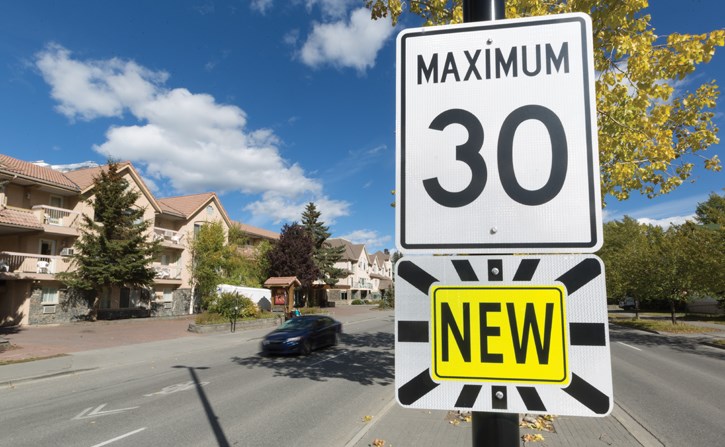BANFF – Politicians have put the brakes on a proposal to lower the speed limit on residential streets in the tourist town to 30 kilometres per hour, preferring to get more public feedback before making a decision.
At a meeting Tuesday (Oct. 9), council directed administration to survey residents on the issue before they consider first reading of a bylaw amendment to set the town-wide speed limit at 30 km/h.
Mayor Karen Sorensen said she heard concerns of people opposed to the idea at council’s meeting, noting if council passes first reading it would also trigger a public hearing to get further input.
“Having this discussion with the community is a valuable discussion to have and I’m not prepared to vote against it and shut the whole idea down today,” she said.
Banff’s current traffic bylaw sets the speed limit at 40 km/h.
However, the posted speed is 30 km/h on Banff Avenue, Middle Springs Drive, Cougar Street, part of Buffalo Street near Surprise Corner and Glen Avenue, as well as playgrounds and school zones.
Middle Springs resident Ron Tessolini voiced opposition to 30 km/h, noting other options such as additional bike lanes should be explored.
“As it is at 40 km/h, I’m riding my brakes all the way down the hill, and if it’s going to be 30 km/h, I’ll probably be standing on my brakes,” he said.
Tessolini also said Banff Avenue’s speed limit should go back up to 40 km/h or 50 km/h.
“I find it extremely frustrating going down Banff Avenue and I’m doing the speed limit and people are passing me all the time,” he said.
Tessolini said work zones on the Trans-Canada Highway are 50 km/h to protect workers.
“That’s deemed acceptable to protect workers that are working directly at the work zone,” he said. “So if it can be 50 km/h on the Trans-Canada, I don’t know why it can’t be 40 km/h or 50 km/h in Banff.”
Town of Banff officials say lower speed limits help cyclists and pedestrians feel safer, noting it could also encourage more people to leave their vehicles at home and choose other active modes of transportation.
“There are some that feel 30 km/h, or any lower speed limit, that there’s a vacation feel and a feeling of safety,” said Chad Townsend, the municipality’s environmental manager.
“We feel this is worth considering. We’re relatively inconsistent throughout town in our speed limits.”
Councillor Chip Olver said it would cost about $6 million to narrow the median on Banff Avenue to make enough room to create a dedicated bike lane.
“To reduce the speed limit and save $5 million or $6 million on an infrastructure project is something that’s appealing to me,” she said.
“The other issue is safety and I think school zones have had it right for many years. When you slow down to 30 km, it’s been shown that there’s less injury and less chance of fatality at slower speed limits.”
Long-term resident Lori Dowling opposed lowering the speed limit to 30 km/h, and in fact, called for Banff Avenue to go back up to 40 km/h, noting no pedestrians, cyclists or skateboarders have ever been killed in Banff.
She said the Town was unfairly targeting one user group – motorists.
“All should bear equal responsibility for their actions. Pedestrians who are so busy looking at their smart phones that they blindly step in front of moving vehicles,” she said.
“Skateboarders and cyclists that blast through stop signs, squeeze between moving and parked vehicles, or fail to signal their intentions, should be made equally responsible for making the roads safer.”
Mayor Sorensen said she stands by her vote three years ago to lower the speed on Banff Avenue to 30 km/h, noting it is a matter of safety in her opinion.
“I like the concept of when people are entering Banff that they’re just slowing down. People are staring at the mountains, they don’t know where they’re going and so I’m supportive of 30 km/h coming into Banff,” she said.
“It’s the nature of the beast. If it’s 30 people are going 40. When it’s 40 people were doing 50. I don’t know at what point you’re going to get a ticket on Banff Avenue – if it’s 41 km/h or 38 km/h – but I’m happy to see that speed come down 10 km/h as people enter town.”
Councillor Peter Poole said he’s grown comfortable with 30 km/h on Banff Avenue, more so than he expected.
“I expected that I would be really frustrated at 30, but I’ve adjusted my behaviour,” he said.
Given the small geographic size of Banff – four-square-kilometres – this proposed town-wide speed change is estimated to add no more than a few minutes to any vehicle journey within the community.
“I think a restriction on our travel time of two minutes to get to Valleyview or Middle Springs is significant, but it’s not a big difference compared to other things we do in our life,” said Coun. Poole.
Last month, Calgary city councillors voted to drop the speed limit on some residential streets and administration is now studying if it should be dropped from 50km/h to 40-km/h or 30-km/h.
Airdrie made the change to 30km/h on its residential streets in the early 1980s and several streets in Cochrane were lowered to 30-km/h this summer.
Earlier this summer, the Town of Canmore approved an update to its integrated transportation plan that recommended lowered speed limits throughout the community in residential neighbourhoods.
It recommended 30 km/h for residential streets and collector roadways and 50 km/h for arterial streets.




